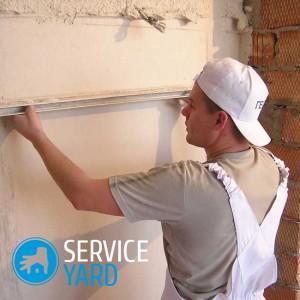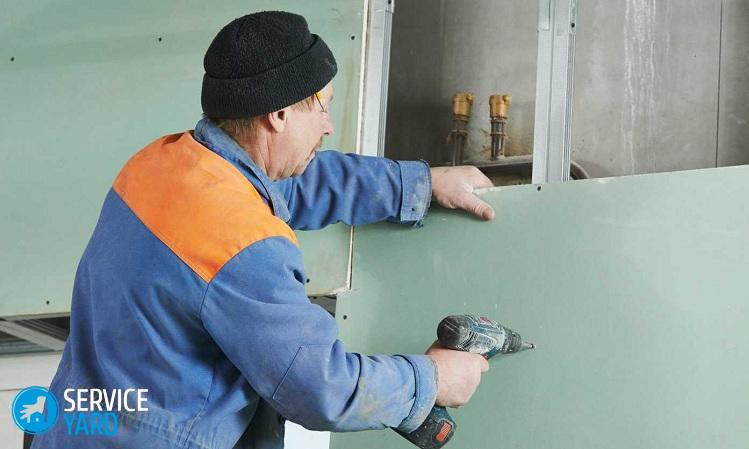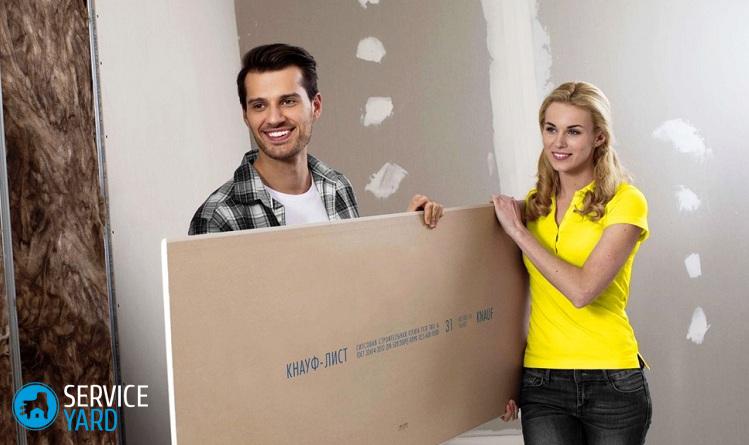How to glue drywall to the wall?

Drywall is a versatile material. If you have the initial concepts of construction, you can install it yourself, while saving a very significant amount for repairs. But before gluing drywall to the wall, it is necessary to take into account the specifics of its installation indoors, to conduct a series of preparatory work, as well as prepare the necessary tools. Next, we will consider the features of the GKL installation in rooms with different degrees of humidity and temperature conditions, as well as methods of wall cladding from various materials.
to contents ↑Methods for wall cladding with drywall sheets
Wall decoration with this type of building materials can occur in two ways:
- A frame is mounted around the perimeter of the room, onto which GCR is directly screwed.
- GCR is glued to the wall using a special adhesive.
to contents ↑Important! Today, professional builders are less and less in the construction process using the method with the construction of the frame, especially for small premises. After all, after the profiles are installed, the room will have even more cramped space.
Mounting tools
If you decide to mount drywall yourself, take care of all the necessary tools in advance.
Important! Also, when choosing glue and auxiliary compositions, pay attention to the features of the room where the repair will take place.
To stick GKL quickly and efficiently, you will need the following inventory:
- To apply glue, use notched and wide spatulas;
- Rule
- Capacity for solution preparation;
- A sharp knife for cutting drywall;
- Water level or plumb;
- Drill, and also a nozzle for a batch;
- Wooden hammer for leveling the surface;
- A clean flap of cloth and a container of water to clean the surface of excess glue;
- Waterproofing materials in the case of installing gypsum plaster in a room with high humidity.
Drywall mixes
Masters who are professionally engaged in repairs recommend using only proven brands of dry mixes, and also do not save on their quality. Thus, GKL, glued to the wall, will firmly adhere to the surface and it is possible to securely lock cabinets and shelves of various weights with confidence.
Important! When buying gypsum plasterboard from a specific manufacturer in a hardware store, it is better to choose a gluing mixture for the same brand. This is due to some features of the production of building materials and will provide you with an optimal level of fasteners.
The most reliable and popular means by which you can glue drywall to the wall are the following:
- Knauf (Perlfix) - the product has excellent technical characteristics, good adhesion to various types of surfaces. In construction stores, the product is in great demand.
- Volma-installation - the quality of raw materials is slightly inferior to the previous one, however, the technical characteristics of the components are of high class.
- Ivsil Plast - the mixture is of good quality and has high adhesion.The advantage of this material is a lower consumption of raw materials compared to the amount of funds from another manufacturer.
Preparation of walls for plasterboard finishing
Before gluing drywall to the wall, you must first prepare the surface. In this case, the finishing material will stay on it better and better:
- First of all, the walls need to be cleaned of dirt, dust and traces of the old finish.
- Roughnesses and cracks on the walls are covered with cement or gypsum putty.
Important! Choosing a mixture for leveling the walls is necessary depending on the surface material.
- For better adhesion of GCR to the wall surface, it must be treated with a special primer.
Important! In construction stores, glue is sold in bags weighing 30 kg. The consumption of the adhesive mixture is approximately 5 kg per 1 square meter. Before gluing drywall, try to calculate the required amount of glue so that it is enough for the entire process of finishing work.
Recommendations for the preparation of the adhesive mixture:
- GKL glue should be prepared immediately before application to the wall, since the mixture becomes solid in a very short time, and its use in the future is impossible.
Important! Prepare the adhesive mixture approximately 30 minutes before applying it.
- During preparation, strictly follow the manufacturer's recommendations and the proportions indicated on the package.
Features of applying glue to GCR:
- GKL glue most manufacturers recommend applying directly to the sheet.
- The mixture is applied to the surface pointwise, with an interval of ten centimeters around the perimeter and center of the sheet.
- If the walls are not too even, the thickness of the applied adhesive should not exceed 3 cm. It is applied to the surface with a spatula.
- In the case of perfectly even walls, the adhesive is applied with a notched trowel to the entire surface of the GCR with a thin layer.
How to glue drywall to the wall?
After the preparatory work, it's time to find out how to properly drywall the wall. Next, we will consider the most common options for wall decoration from various materials.
How to glue drywall on the wall with foam?
Among the masters who carry out finishing work, there is an opinion that if GKL is glued using a mounting foam, then this installation option will additionally insulate the room.
Work sequence:
- Special plugs are installed on the surface of the wall, into which screws for gypsum plaster are subsequently screwed, and facing is installed on them.
- Using a screwdriver or a screwdriver, the self-tapping screw is unscrewed from the cork to the required distance.
- Small holes are made in the drywall sheet through which the mounting foam is blown.
- Foam begins to expand, and the sheet moves away from the walls to a distance limited by screws.
Important! This installation method is practically not used in construction, since the cost and consumption of foam is quite large relative to the consumption of special glue for drywall.
Finishing a concrete flat wall GKL
Installation of wiring is carried out before facing the walls with drywall. Make holes for wiring. All wires are fixed with clamps at a distance of 50 cm.
Procedure:
- On the wall, mark the locations of sockets and switches, make nests for them.
- Concrete wall is treated with a special primer for concrete.
- On each sheet on a flat surface with a sharp knife, make holes for sockets and switches.
- The adhesive mixture is applied with a notched trowel to the entire surface with a thin layer around the perimeter and the center of the GCR.
- You can align the glued sheet with a special rule and a building level, evenly pressing it against the wall.
- Remove excess mixture from the surface with a dry, clean cloth.
Rough brick wall cladding
The adhesive mixture on the gypsum board is applied exclusively by a point method.In addition, the density of the mixture and the thickness of its deposition are significantly different from the previous method.
Procedure:
- Around the perimeter of the entire sheet in a dotted manner at a distance of 25 centimeters apply glue.
- Further along the center of the drywall along the entire length at a distance of 50 cm from each other lay a number of points, with a distance between them of 30 cm.
Important! The thickness of the applied adhesive blot should be 5-30 mm.
- Carefully align the glued sheet with your hand so as not to damage the lining, while using the level and the rule.
Important! It is desirable to carry out this type of finishing work with an assistant, since the gypsum board has considerable weight and dimensions, and it is quite difficult to lift it alone.
Finishing too rough walls GKL
If the walls in the room are too uneven, and it was decided to finish them with drywall, such a surface requires additional preparation.
Procedure:
- Stripes 10 cm wide are cut from the finishing sheet.
- Of the cut strips form a special frame for finishing work. The distance between the strips of the crate is 40-60 cm.
Important! The distance between the strips depends on the degree of unevenness of the walls.
- In some cases, it is very appropriate to fix the finish sheet in the corners with screws.
- The solution for gluing the finishing material is recommended by the master to be thicker. Since the mixture hardens quickly enough, it must be applied quickly.
to contents ↑Important! For processing uneven walls, based on the experience of the masters, the best option is Knauf glue (Perlfix). Due to its technical characteristics, it is durable and is considered the most reliable means for attaching GCR.
Recommendations regarding the installation of drywall in a room with high humidity
At all thematic forums, the question is often asked, is it possible to glue drywall on the wall in rooms with high humidity? Drywall in such rooms can be installed without fear. However, to extend the life of your finish, you must follow some rules:
- Glue the lining only on a completely dry surface, previously treated with a special antiseptic primer with deep penetration.
- To finish the surface in the basement or pool, the walls are covered with a layer of waterproofing mastic.
- In a room with high humidity, a stationary hood should be installed.
- Joints and seams on the lined surface must be carefully plastered and waterproofed, because this is the most vulnerable finish.
- At the end of the finishing work, the surface must be coated with a paint with a water-repellent effect or other means resistant to moisture.
to contents ↑Important! Wall lining in a room with high humidity is carried out only by moisture-resistant GCR. A distinctive characteristic of this material is the specific blue color.
Stock footage
As you can see, it is quite simple to carry out wall decoration with drywall without a certain building experience. It is only important to comply with certain conditions for its installation and adhere to recommendations. Unfortunately, with this method it is not possible to perform complex architectural structures, but it is quite realistic to level the surface of the walls for further finishing. The tips from the article will help to achieve the desired result and make the walls in the room perfectly smooth.
- How to choose a vacuum cleaner taking into account the characteristics of the house and coatings?
- What to look for when choosing a water delivery
- How to quickly create comfort at home - tips for housewives
- How to choose the perfect TV - useful tips
- What to look for when choosing blinds
- What should be running shoes?
- What useful things can you buy in a hardware store
- Iphone 11 pro max review
- Than iPhone is better than Android smartphones





